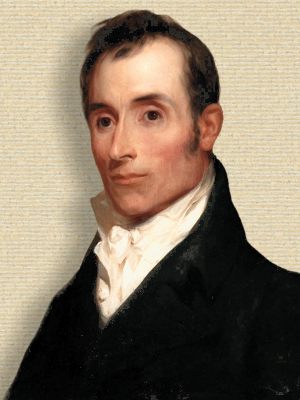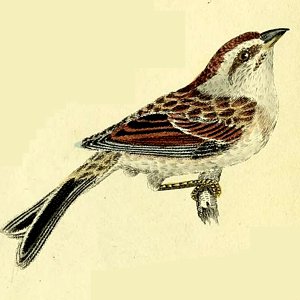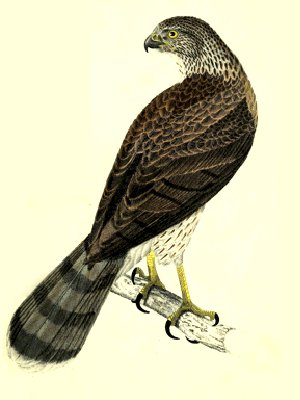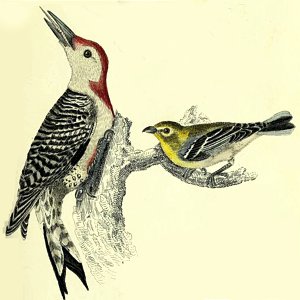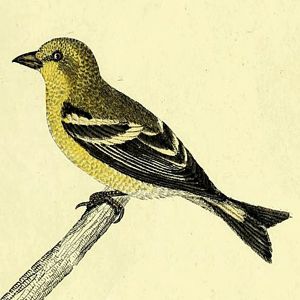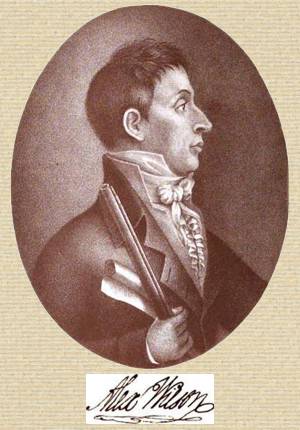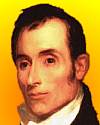 (source)
(source)
|
Alexander Wilson
(6 Jul 1766 - 23 Aug 1813)
Scottish-American ornithologist and poet who traveled extensively to make paintings of the birds he observed. His pioneering work was published in nine volumes of illustrations as American Ornithology.
|
ALEXANDER WILSON
Ornithologist
1766-1813
By Witmer Stone
from Leading American Men of Science (1910)
[p.51] Alexander Wilson has been termed “the father of American Ornithology,” and not without reason. He was not the pioneer writer upon American birds as Catesby, Forster and others preceded him by many years, but to him we are indebted for the first comprehensive work on the birds of our country at large, and the first work which merited the title that he bestowed upon it, American Ornithology.
Wilson’s Ornithology was not a scientific work so far as matters of anatomy and taxonomy were concerned. Indeed, knowledge of these subjects was not very far advanced at that day and our author had given them little attention. His aim was to picture each bird as accurately as his skill permitted both with brush and pen and to include in his text, backgrounds and sidelights upon its life and haunts drawn from his travels and rambles through wood and field.
Love of nature always predominates over technique and this spirit of the Ornithology seems to have pervaded much of our subsequent ornithological literature to a great extent. Possibly the nature of the study is to some degree responsible, but this early work seems to have set a style which has been followed in the volumes that have succeeded it.
Wilson’s character is in no small degree reflected in his work. He was not a scientific man in the modern sense, not a closet naturalist, but a poet who loved nature for herself and he took up the study of ornithology not as science but because the beauty of the birds and the melody of their songs appealed to him.
[p.52] He later recognized the importance of scientific accuracy and bibliographic research, but this came as a secondary result of the line of work upon which he had set out, and was not a primary interest with him. His Ornithology was born in the woods not in the museum or library.
Wilson was doubtless acquainted with the birds of his native country and knew them by name just as he knew the thistle, the heather and the bracken, for upon landing in America one of his first comments was upon the strange birds and shrubs that surrounded him, but there is no evidence that he had any early inclination toward the study of birds except as they formed a part of nature which was ever dear to him.
Every lover of nature seems to have within him more or less latent talent for art, poetry and natural history, and circumstances largely determine which of the three comes most prominently to the surface. In Wilson, poetry first filled his mind and became the aim of his life, but his talent in this direction was not sufficiently great to earn him conspicuous notoriety and it was as a chronicler of nature that he became famous though he did not enter upon this rôle until the last decade of his life.
Alexander Wilson was born in the Seedhills of Paisley in Renfrewshire, Scotland, July 6, 1766, the son of Alexander Wilson and Mary McNab. The early death of his mother may have had some effect upon his after life as it is said that she intended that he should study for the ministry. However this may be his father and stepmother seem to have done as much for him as their poverty and the large size of their family permitted. He attended the Paisley grammar school and learned to read and write, but was compelled in later life to make up for many deficiencies which had they been supplied at the proper time would have aided him greatly in his life’s work.
While a small boy he was engaged for a short time, at least, as a cattle herd on the farm of Bakerfield, but when only thirteen years of age became apprenticed to his brother-in-law, William Duncan, to learn the “art of weaving” which was the occupation of nearly all of his friends and relatives.
[p.53] Even at this time Wilson was writing verses and his mind was ever turning to the outdoor life which was dear to his heart and in comparison with which the loom was a sorry bondage. As the only visible means of earning a living he continued weaving until 1789 when he joined his brother-in-law in a tour of eastern Scotland as a peddler. This undertaking was prompted by his love of tramping and his restlessness under uncongenial confinement; not by any love or ability for trading, for that he did not possess. While gratifying his taste for outdoor life he was by no means benefited financially by the change. However, he gave full rein to his poetical ambition, and with his characteristic impetuosity he soon had visions of publishing his volume of verses and sharing in the notoriety that had just greeted the issue of Burns’ first poems. Wilson was evidently acquainted with Burns as some of his verses show and entertained a very high opinion of him. To what extent Burns’ success may have influenced him or his style is hard to say, but one of the best of Wilson’s productions published anonymously was attributed to the “plowman,” doubtless to the author’s great gratification.
Wilson reached the height of his practical ambition in 1790 when he published a volume of his poetical writings. It was, however, an indifferent production and failed to bring him the renown that he coveted. In 1792 he was back at the loom but as before despondent and unhappy and in sore straits financially. He continued to publish occasional poems in the local papers and now and then indulged in sarcastic verses on certain civil authorities and other self-important personages. This practice finally brought him face to face with libel charges, resulting in fines and imprisonment.
Upon his release, consumed with bitterness and more despondent than ever he resolved to leave his native country and try his fortune in America. Accordingly, accompanied by his nephew, William Duncan, he sailed from Belfast on May 23, 1794, and reached the mouth of Delaware bay on the 11th of July.
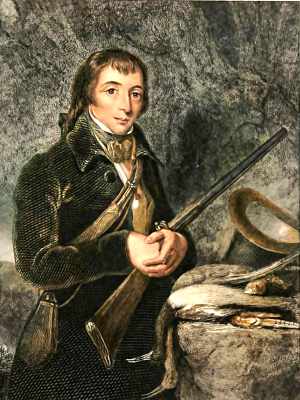
Impatient to be once more ashore they landed at New Castle, Delaware, “happy as mortals could be” and went on foot to [p.54] Wilmington and thence to Philadelphia through virgin forest most of the way, past log cabins, and occasional farms. “On the way,” Wilson writes to his parents, “I did not observe one bird such as those in Scotland but all much richer in color … some red birds, several of which I shot for our curiosity.” This quotation is worthy of note as it shows an early interest in birds and an appreciation of the difference in the avi-fauna of the two countries. At the same time we find no further mention of birds in his correspondence for many years.
The two weavers found no opening for men of their trade in Philadelphia and seem to have been compelled to accept any kind of employment that was offered. Wilson, always of a delicate constitution and unfitted for hard labor, succeeded in securing a school first at Frankford and later at Milestown, a short distance north of the city. The requisites of the country schoolmaster were not very severe at this time, and as Wilson wrote a good hand and had always been a reader his education, in spite of early shortcomings, was apparently fully equal to the calls made upon it. With the idea of advancing in this profession he seems to have been constantly endeavoring to improve himself in mathematics and other studies in which he recognized himself as deficient.
His particular friend at this period of his life was Charles Orr, a writing master in Philadelphia and a man of studious nature with whom Wilson maintained an active correspondence. His letters of September, 1800, show that he had been forced to relinquish his school on account of ill health, but at the earnest request of the trustees agreed to try it again. “I was attached to the children and to the people,” he wrote, “and if they would allow me one week more to ramble about, I would once more engage, though I should die in their service. My request was immediately acceded to, and I am once more the dominie of Milestown school.” Later he writes, “I have begun the old way again and have about thirty scholars. I study none and take my morning and evening ramble regularly. Do you spend any of your leisure hours with the puzzling chaps, algebra and trigonometry, etc., or are you wholly absorbed in the study of mechanics? You must write me particularly. [p.55] I think I shall take a ride 15 or 20 miles on Saturday. I find riding agrees better with me than any other exercise. I always feel cheerful after it, and can eat confoundedly. Have you made any new discoveries in the Heaven above, or the earth beneath, with your telescope or microscope?”
At this time his nephew had moved to Ovid, Cayuga county, New York, where they had purchased a tract of land and begun to farm. Other members of his family came hither from Scotland and it seems to have been Wilson’s intention to join them though he afterwards abandoned the idea.
In 1801 Wilson left Milestown and obtained a school at Bloomfield, N. J., where he remained about a year. He seems to have had little trouble in securing positions. School-teachers, were, to be sure, scarce and salaries small, as he complained bitterly with respect to his Bloomfield engagement where the people “paid their minister 250 pounds a year for preaching twice a week and their teacher 40 dollars a quarter for the most spirit-sinking, laborious work, six, I may say twelve times weekly.”
300x300px.jpg)
Wilson, however, seems to have possessed the requisites of a teacher in no small degree; he was both a disciplinarian and an instructor and succeeded in his main object, that of imparting knowledge to his pupils. He also seems to have gained the respect and good-will of the people among whom he established himself so that they were loath to have him leave them. In describing his Bloomfield school he writes: “The schoolhouse in which I teach is situated at the extremity of a spacious level plain of sand thinly covered with grass. In the centre of this plain stands a newly erected stone meeting-house, 80 feet by 60, which forms a striking contrast with my sanctum sanctorum, which has been framed of logs some 100 years ago, and looks like an old sentry box. The scholars have been accustomed to great liberties by their former teacher. They used to put stones in his pocket, etc., etc. I was told that the people did not like to have their children punished, but I began with such a system of terror as soon established my authority most effectually. I succeed in teaching them to read and I care for none of their objections.”
[p.56] Wilson became involved in a love affair while at Milestown, which did not end happily for him, and his sensitive nature ever subject to fits of despondency became more than ever affected during his stay at Bloomfield where he was surrounded by strangers. He proposed to his friend Orr that they open a school somewhere under their joint management; he even thought of turning his back upon his adopted country and returning to the shores of Caledonia, and meanwhile he consoled himself in his solitude with writing poems.
In February, 1802, he moved again, this time to take charge of the school at Gray’s Ferry just outside the city of Philadelphia. He had evidently not recovered from his despondency, as he writes, “I shall recommence that painful profession once more with the same gloomy sullen resignation that a prisoner re-enters his dungeon or a malefactor mounts the scaffold; fate urges him, necessity me. The present pedagogue is a noisy, outrageous fat old captain of a ship, who has taught these ten years in different places. You may hear him bawling 300 yards off. The boys seem to pay as little regard to it as ducks to the rumbling of a stream under them. I shall have many difficulties to overcome in establishing my own rules and authority. But perseverance overcometh all things.”
Little did Wilson suspect that this last move would prove the turning-point of his life and raise him from oblivion to fame though not in the field in which he had always imagined that his genius lay.
Amid the green fields and the budding woods of early spring he forgot his troubles and his spirits rose again with their characteristic impetuosity. Poetry as usual was his resource: “My harp is new strung,” he writes, “and my soul glows with more ardour than ever to emulate those immortal bards who have gone before me … my heart swells, my soul rises to an elevation I cannot express.”
But poetry was soon to take second place in his consideration.
Close to Gray’s Ferry lay the homestead of the Bartrams, a curious old stone mansion surrounded by the historic botanical [p.57] garden the pride of the famous old botanist, John Bartram. Here there were living at this time the two sons of the original proprietor, John and William Bartram. The latter, then a man, of sixty-one years of age, was a botanist of perhaps quite as much ability as his father, while he also possessed a hoard of knowledge on general natural history equalled by but few men of his time. He had traveled when a young man through Georgia, Carolina and Florida and published a report on his travels. Being exceedingly modest, however, he never sought fame by further publications, though he generously aided all who came to him for assistance and advice and shared with them his store of knowledge.
Between Bartram and Wilson a close intimacy immediately sprang up, and the association with the venerable naturalist and the atmosphere which prevaded the botanic garden soon kindled into flame the latent interest in birds which up to that time had been dominated by the spirit of poetry.
Ornithology was almost as much a hobby with Bartram as botany, and he had published in his Travels a list of the birds of eastern North America, consequently he gave every encouragement to the development of this taste in his young friend.
The meagerness and inaccuracy of the literature of American ornithology, and the obvious need of science for the knowledge that he felt he could supply strongly appealed to Wilson, while the recreation from his confining school duties which the pursuit of this study would afford him, was an additional allurement.
In 1803 he writes to a friend, “I have had many pursuits since I left Scotland … and I am now about to make a collection of all our finest birds.”
The first essential in natural history research in those days was the preparation of drawings of the objects studied, and Wilson being by no means an artist born set about the laborious task of learning to draw. Night after night he worked patiently with brush and pencil in his efforts to produce satisfactory pictures of the birds which he shot. Alexander Lawson, the engraver, gave him instruction and Miss Nancy Bartram, a niece of the naturalist, also helped him. Wilson never attained much artistic ability, [p.58] but his sole object, the production of faithful bird portraits, he did accomplish and in a style superior to any work published up to that time and to many that came after.
Some of his first efforts he sent to Bartram with the following explanation: “The duties of my profession will not admit me to apply to this study with the assiduity and perseverance I could wish. Chief part of what I do is sketched by candle-light, and for this I am obliged to sacrifice the pleasures of social life, and the agreeable moments which I might enjoy in company with you and your amiable friend. I shall be happy if what I have done merits your approbation.” To Lawson he writes about this time, “Six days in one week I have no more time than just to swallow my meals and return to my Sanctum Sanctorum. Five days of the following week are occupied in the same routine of pedagoguing matters; and the other two are sacrificed to that itch for drawing, which I caught from your honorable self. I am most earnestly bent on pursuing my plan of making a collection of all the birds in this part of North America. Now I don’t want you to throw cold water, as Shakespeare says, on this notion, Quixotic as it may appear. I have been so long accustomed to the building of airy castles and brain windmills, that it has become one of my earthly comforts, a sort of a rough bone, that amuses me when sated with the dull drudgery of life.”
Quoting again from his letters as the best record we have of his progress, we find him writing to Bartram in March, 1804:
“I send for your amusement a few attempts at some of our indigenous birds, hoping that your good nature will excuse their deficiencies, while you point them out to me. I am almost ashamed to send you these drawings, but I know your generous disposition will induce you to encourage one in whom you perceive a sincere and eager wish to do well. They were chiefly colored by candle light.
“I have now got my collection of native birds considerably enlarged; and shall endeavour, if possible, to obtain all the smaller ones this summer. Be pleased to mark on the drawings, with a pencil, the name of each bird, as, except three or four, I do not know them. I shall be extremely obliged to you for every hint [p.59] that will assist me in this agreeable amusement. I declare that the face of an owl, and the back of a lark, have put me to a nonplus; and if Miss Nancy will be so obliging as to try her hand on the last mentioned, I will furnish her with one in good order, and will copy her drawing with the greatest pleasure; having spent almost a week on two different ones, and afterwards destroyed them both, and got nearly in the slough of despond.”
The next two years passed rapidly at Gray’s Ferry. Wilson concentrated his attention upon the collecting and drawing of birds, while his leisure moments were spent in the company of his friend and adviser, for whom his love and esteem were constantly increasing. “I confess,” he writes, “that I was always an enthusiast in my admiration of the rural scenery of Nature; but since your example and encouragement have set me to attempt to imitate her productions, I see new beauties in every bird, plant, or flower I contemplate; and find my ideas of the incomprehensible First Cause still more exalted, the more minutely I examine His work.” And again regarding some more drawings sent to Bartram, “Criticise these, my dear friend, without fear of offending me—this will instruct, but not discourage me. For there is not among all our naturalists one who knows so well what they are, and how they ought to be represented. In the mean time accept of my best wishes for your happiness—wishes as sincere as ever one human being breathed for another. To your advice and encouraging encomiums I am indebted for these few specimens, and for all that will follow. They may yet tell posterity that I was honored with your friendship, and that to your inspiration they owe their existance.”
Meanwhile the school went on and the scholars became interested in gratifying their master’s tastes. “I have had live crows, hawks and owls, oppossums, squirrels, snakes, and lizards,” writes Wilson, “so that my room has sometimes reminded me of Noah’s ark; but Noah had a wife in one corner of it, and in this particular our parallel does not altogether tally. I receive every subject of natural history that is brought to me and though they do not march into my ark from all quarters, as they did that of [p.60] our great ancestor, yet I find means, by the distribution of a few five-penny bits, to make them find the way fast enough. A boy, not long ago, brought me a large basket full of crows. I expect his next load will be bull-frogs, if I don’t soon issue orders to the contrary.”
The winter of 1804-05 was very severe and the suffering was great. Many scholars were unable to continue in attendance at Wilson’s school-house and he was in such financial straits that he was forced to propose giving up his position. The trustees, however, would not hear of it and immediately raised sufficient funds to retain his services.
In October, 1804, Wilson took a journey mainly on foot to visit his nephew at Ovid, continuing to Niagara Falls and returning to Gray’s Ferry in December. This trip inspired his last lengthy poem, which was separately published as The Foresters being in fact a narrative of the trip in verse. The varied scenery also stirred up the old spirit of restlessness, and he wrote to Bartram of the advisability of becoming a traveler “to commence some more extensive expedition, where scenes and subjects entirely new, and generally unknown, might reward my curiosity; and where perhaps my humble acquisitions might add something to the store of knowledge.” He also asked how he might best acquire a knowledge of botany and mineralogy.
Whatever Bartram’s advice may have been Wilson seems to have continued his study of scientific literature with redoubled vigor. His letters at this time contain comments and criticisms on current publications which indicate a considerable breadth of knowledge, and early in the following year he was appointed assistant editor of Rees’s New Cyclopaedia, then being published by Bradford and Company of Philadelphia. He received a “generous salary” of $900 per year and was at last freed from the drudgery of his school, though for a time at least his work was more confining and necessitated his residence in the heart of the city which he thoroughly detested.
Almost from the time Wilson set foot on American soil he became strongly attached to the country, and his letters to friends at [p.61] home constantly boast of the resources and possibilities of the States. President Jefferson commanded his deep respect and admiration, especially on account of his scientific attainments, and to him he seems to have looked for some assistance in the prosecution of his ornithological studies. He sent him with much diffidence drawings of two birds which he had secured on his journey to Niagara and received a very appreciative letter from the president. Encouraged by this Wilson wrote again just before receiving his editorial appointment and applied for a position on the expedition then being fitted out by the government under Captain Nicolas Pike to explore the sources of the Arkansas River; no attention, however, was paid to his application.
The idea of publishing the results of his bird studies seems to have taken definite shape in Wilson’s mind toward the end of the year 1805, and he at that time was making attempts at etching on copper. Catesby for economy’s sake etched his own plates, and Wilson being no better situated financially probably saw no other way to reproduce his drawings. His first efforts which Ord tells us were plates one and two of the Ornithology were sent to Bartram on November 29, 1805, and January 4, 1806, the latter one accompanied by the following note: “Mr. Wilson’s affectionate compliments to Mr. Bartram; and sends for his amusement and correction another proof of his Birds of the United States. The coloring being chiefly done last night, must soften criticism a little. Will be thankful for my friend’s advice and correction.” In the letter to President Jefferson above alluded to, he clearly states his purpose of publishing as he says, “Having been engaged, these several years, in collecting materials and finishing drawings from Nature, with the design of publishing a new Ornithology of the United States of America, so deficient are the works of Catesby, Edwards, and other Europeans, I have traversed the greater part of our northern and eastern districts; and have collected many birds undescribed by these naturalists. Upwards of one hundred drawings are completed, and two plates in folio already engraved.”
By April, 1807, the propectus was ready, and apparently dissatisfied with his own efforts he had engaged Alexander Lawson to [p.62] etch the plates. The remuneration could not have been great and the profits were lessened by the labor that was necessary to bring the plates up to the author’s ideal. In fact Lawson told Ord that he found frequently his reward did not amount to more than fifty cents a day, but he was so anxious to encourage his friend that he made no complaint and his work was in a great measure a labor of love. In planning for the publication Wilson no doubt derived great benefits from his association with Bradford and Company and it was of course this house which was to issue the work.
In the autumn of 1808, with a sample copy of volume one, he started upon a personal canvass of the country for the two-hundred and fifty subscribers which were considered necessary before the publication could be seriously prosecuted, the subscription price being $120. Traveling by stage and on foot he visited Princeton, New York, New Haven, Boston and Portland Maine, and returned by way of Dartmouth College and Albany, stopping at all the smaller towns on the way where possible subscribers might be found. His success was varied; scientific men of means subscribed as did many prominent citizens interested in the advancement of literature and science. Many others, however, while lavish in praise of his beautiful pictures were appalled at the price and still others seemed to totally lack appreciation of the merits of his work. Governor Tompkins of New York, afterwards Vice-President of the United States, said, “I would not give a hundred dollars for all the birds you intend to describe, even had I them alive.”
Such rebuffs must have been hard to bear, but Wilson had plenty of pluck and his letters home while avoiding any mention of his success are full of descriptions of the places he visited. Every spot of historic interest inspired him with respect. He visited Bunker Hill with a feeling of veneration and was surprised that the people living in the vicinity did not seem to share it.
Upon his return to Philadelphia Wilson set out almost immediately upon a southern tour, visiting Washington, Charleston, and [p.63] Savannah, in which latter city he succeeded in bringing the total of his subscription list up to the requisite two hundred and fifty; “having,” to quote his own words, “visited all the towns within one hundred miles of the Atlantic from Maine to Georgia and done as much for this bantling book of mine as ever author did for any progeny of his brain.” His experience in the south was much like that in the north. “In Annapolis,” he writes, “I passed my book through both Houses of the Legislature; the wise men of Maryland stared and gaped, from bench to bench; but having never heard of such a thing as one hundred and twenty dollars for a book, the ayes for subscribing were none.”
In Charleston he found such “listlessness and want of energy” that he could get no one to draw him up a list of likely subscribers and “was obliged to walk the streets and pick out those houses, which, from their appearance indicated wealth and taste in the occupants, and introduce myself.” However, his task was accomplished, and flushed with success he embarked for Philadelphia in March, 1809, ready to push the publication of his volumes with all possible haste.
Wilson’s canvassing trips were profitable in other ways than the securing of subscribers. His scientific acquaintances had hitherto been mainly limited to Philadelphia or to such visitors as he met at Bartram’s hospitable mansion. He knew Thomas Say, George Ord, Benjamin S. Barton, and the Peales, while he had met Michaux and Muhlenberg, the botanists. Now, however, in every town he sought out those interested in Natural History. As he himself put it: “Whatever may be the result of these matters, [subscriptions] I shall not sit down with folded hands. … I am fixing correspondents in every corner of these northern regions, like so many pickets and outposts, so that scarcely a wren or tit shall be able to pass along, from New York to Canada, but I shall get intelligence of it.…”
Notable among his new acquaintances was Abbott of Georgia, famous for his publication on the insects of his native state. With him he arranged for the forwarding of such southern birds as he was personally unable to secure as well as any that were in Abbott’s [p.64] estimation new to science. These Wilson agreed to pay for through his agent in Savannah.
In January, 1810, the second volume of the Ornithology appeared, and shortly afterward Wilson started westward to explore the ornithological terra incognita that lay beyond the Alleghanies. He had for some years realized the necessity of exploring this country as he supposed there were many birds to be found there which never came east of the mountains. In 1805 he had arranged such an excursion in company with Bartram, but the failing health of the venerable botanist finally compelled him to relinquish all thought of going, while Wilson, after failing to receive an appointment upon the government expedition, also abandoned the project as he realized that his finances would not warrant such an undertaking. Now, however, the expedition was imperative both on account of the probable scientific results and the possible subscribers to be obtained in the towns of the Ohio and Mississippi Valleys.
His route lay from Pittsburg down the Ohio, which he traversed in a rowboat, as far as Louisville. There he sold his skiff to a man who wondered at its curious Indian (!) name “The Ornithologist,” and set out on foot to Lexington and Nashville. He visited the Mammoth Cave and sent to the editor of the Portfolio in Philadelphia letters containing a careful description of this and other interesting points that he passed on his journey.
Before leaving Nashville he wrote to a friend, “Nine hundred miles distant from you sits Wilson, the hunter of birds’ nests and sparrows, just preparing to enter on a wilderness of 780 miles, most of it in the territory of Indians,—alone, but in good spirits, and expecting to have every pocket crammed with skins of new and extraordinary birds before he reaches the City of New Orleans.”
The territory of Mississippi through which Wilson traveled alone on horseback was then mainly populated by the semicivilized Indian tribes which were afterwards transported to the present Indian Territory and he met but few white men. The route was exceedingly difficult, being through dense forests and “most [p.65] execrable swamps.” On the seventeenth day he reached Natchez and from there followed the Mississippi River to New Orleans.
Here he secured a substantial addition to his subscription list and sailed for Philadelphia, well satisfied with his trip. He skirted but did not touch the peninsula of Florida, a land which had he but known it would have yielded him more novelties than that which he had just traversed.
During the years 1811 and 1812 Wilson seems to have lived almost continuously at Bartram’s, which was always such a congenial home to him, and meanwhile the publication advanced rapidly.
After the fifth volume was completed in 1812 he went again to New England to visit his agents and look after his subscribers. Upon his return he devoted himself to the water birds which he had previously somewhat neglected and made a number of excursions across the state of New Jersey to Egg Harbor, then a great resort for sea birds of various kinds. Upon these trips he was accompanied by his friend Ord then about thirty years of age, afterwards president of the Academy of Natural Sciences of Philadelphia. About this time Wilson began to reap the rewards of his labors,— financial reward there was apparently none, since the expense so far had fully equalled the receipts,—but his merit was gaining recognition.
He was elected a member of the American Society of Artists in 1812 and of the American Philosophical Society and the recently formed Academy of Natural Sciences in the following year.
During the summer of 1813 owing to the difficulty of procuring colorists for the plates he attended personally to much of this work and overtaxed himself. His whole energy seems to have been directed toward the finishing of his work. In July he writes, “My eighth volume is now in the press and will be published in November. One more volume will complete the whole.” His constitution, however, which had always demanded plenty of outdoor exercise could not stand this constant application and when shortly after this he was stricken with an attack of dysentery, he [p.66] lacked the requisite strength to resist the disease and after only a few days illness he died on August 23, 1813.
The premature close of such a career was lamentable. With fame just within his grasp and possibilities of various kinds before him, it is difficult to say what Wilson would have accomplished had he been permitted to round out his life.
His friend Ord completed the Ornithology from the fragments left by the author, probably as faithfully and as nearly in accord with Wilson’s ideas as it could have been done, and later published several reprints. The revised editions and further popularization of the work, and a work on North American mammals, all of which Wilson had in mind, could, however, be executed by no other hand. Furthermore the existence of an ornithologist of such preeminent ability must have exerted a decided influence upon the subsequent development of scientific work in America and it is impossible to say what effect his later work might have had upon the productions of those who succeeded him.
The character of Alexander Wilson, the man, may be read in the outline of his life and the history of his work, but his friend Ord has given us a sketch of his personality:
“Wilson was possessed of the nicest sense of honor. In all his dealings he was not only scrupulously just but highly generous. His veneration for truth was exemplary. His disposition was social and affectionate. His benevolence was extensive. He was remarkably temperate in eating and drinking, his love of study and retirement preserving him from the contaminating influence of the convivial circle. But as no one is perfect, Wilson in a small degree partook of the weakness of humanity. He was of the genus irritabile, and was obstinate in opinion. It ever gave him pleasure to acknowledge error, when the conviction resulted from his own judgment alone, but he could not endure to be told of his mistakes. Hence his associates had to be sparing of their criticisms, through a fear of forfeiting his friendship. With almost all his friends he had occasionally, arising from a collision of opinion, some slight misunderstanding, which was soon passed over, leaving no disagreeable impression. But an act of disrespect he could ill brook, and a wilful injury he would seldom forgive.
[p.67] “In his person he was of a middle stature, of a thin habit of body; his cheek bones projected, and his eyes, though hollow, displayed considerable vivacity and intelligence; his complexion was sallow, his mein thoughtful; his features were coarse, and there was a dash of vulgarity in his physiognomy, which struck the observer at the first view, but which failed to impress one on acquaintance. His walk was quick when travelling, so much so that it was difficult for a companion to keep pace with him; but when in the forests, in pursuit of birds, he was deliberate and attentive—he was, as it were, all eyes and all ears. Such was Alexander Wilson.”
So far as we can learn no one differed from the above estimate of the man except Audubon who charges him with failure to acknowledge information that he gave him and with publishing a copy of one of his drawings without credit. These claims were not made until after Wilson was dead and are so at variance with his character as depicted by others that they would seem scarcely worthy of notice were it not that so much has been made of them both by Audubon and his biographers. Audubon at several points in his ornithological writings makes sarcastic remarks about Wilson, and there is every reason to believe that he was much embittered at his failure to secure a publisher for his work in Philadelphia and New York owing to the field being filled by that of Wilson. His relations with Ord and other of Wilson’s supporters, moreover, were not friendly, and these facts doubtless had much to do with his attacks. The meeting between the two ornithologists took place at Louisville in March, 1810, when Wilson was seeking birds and subscribers on his western tour. They were quite unknown to each other even by name or reputation. Audubon at the time was only thirty years of age and had no reputation except among his immediate friends. He had made a number of drawings of birds, but had no thought of publishing them. He accompanied Wilson upon a day’s hunting during his stay in Louisville as Wilson himself states, but the latter doubtless never thought of crediting Audubon with such observations as they may have made, when in each other’s company. As to the drawings, all that Wilson made on this part of his trip were lost, and there is [p.68] absolutely no reason to doubt his statement that he secured the small-headed Flycatcher as he described, inasmuch as Ord immediately published the fact that he was with Wilson when he shot the bird and Lawson stated that he had the specimen before him when engraving Wilson’s plates. Audubon’s memory seems to have been at fault in this instance, and his hostility to Ord doubtless inspired this and other reflections on Wilson, as elsewhere he speaks of him with great kindness.
Wilson entered upon the production of his Ornithology with no motive other than the desire to benefit science, and he expressed no expectations of great financial profit or sensational notoriety. He expended upon the work all the money that he had and was eventually compelled to resign his position as editor of the Encyclopædia so engrossing were the demands of his own publication. At the time the second volume was about ready for the press he wrote to Bartram: “I assure you my dear friend that this undertaking has involved me in many difficulties and expenses which I never dreamed of and I have never yet received one cent from it. I am therefore a volunteer in the cause of Natural History impelled by nobler views than those of money.” In the preface to the fifth volume, too, he says: “The publication of an original work of this kind in this country has been attended with difficulties, great, and it must be confessed sometimes discouraging to the author whose only reward hitherto has been the favorable opinion of his fellow citizens and the pleasure of the pursuit.” There is no evidence that circumstances had altered at the time of his death, and though he speaks with satisfaction of the approval of his friends, his reward even in this line had scarcely begun to reach him when his labors were so suddenly terminated.
In forming our estimate of the value to science of Wilson’s work we naturally compare it with that of other ornithologists. Compared with his predecessors, his chief merit is originality. He had no model upon which to build his Ornithology and was indeed familiar with only the works of Catesby, Latham, Turton, Edwards and Bartram, and the obvious errors which pervade most of these drove him to rely only upon Nature herself for his facts. He broke [p.69] boldly away from all the fables and hearsay reports that fill the pages of the early writers and described only such birds as he had himself seen and such characteristics of habit as he was personally familiar with or which he had first hand from reliable observers.
Thus relying wholly upon his own resources he produced a treatise which at once placed American Ornithology upon a firm basis, and upon the foundation thus laid each subsequent writer from Audubon and Nuttall on, has simply added his portion toward the completed structure. The first writer upon a fauna is in a different position from any of those who come after, and can hardly be fairly compared with them since they have all had his work as a guide.
In the case of Alexander Wilson we find him most frequently compared with Audubon, since their works were of essentially the same compass. From an artistic standpoint Audubon’s work is far superior; he was preeminently an artist, both by birth and education, while Wilson made no pretensions to art; but as a scientific work so far as the country covered by Wilson is concerned it added but little to Wilson’s accounts, and this in spite of the fact that the latter’s bird studies covered but ten years, while Audubon had devoted thirty years to the study before he began publication. Indeed, to the present day but twenty-three indigenous land birds from east of the Alleghanies and north of Florida have been added to Wilson’s list.
To give some idea of the rank of Wilson’s work with the scientific publications of the time we may quote Baron Cuvier to the effect that “he has treated of American birds better than those of Europe have yet been treated.” The impetus that such a work, produced in America and by the support of American subscribers must have given to American science is hard to estimate, as is also the attention which it must have directed toward America as a country which not only possessed a rich fauna and flora but which gave promise of producing men thoroughly capable of making known its riches to the scientific world and among the van of this assemblage stands Alexander Wilson, a Scotchman by birth but an American in his interests and sympathies.
- Science Quotes by Alexander Wilson.
- 6 Jul - short biography, births, deaths and events on date of Wilson's birth.
- Alexander Wilson: Naturalist and Pioneer,: A biography, by Robert Cantwell. - book suggestion.
